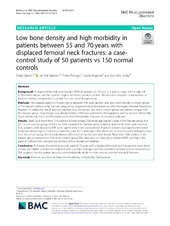| dc.contributor.author | Bartels, Stefan | en_US |
| dc.contributor.author | Gjertsen, Jan-Erik | en_US |
| dc.contributor.author | Frihagen, Frede Jon | en_US |
| dc.contributor.author | Rogmark, Cecilia | en_US |
| dc.contributor.author | Utvåg, Stein-Erik | en_US |
| dc.date.accessioned | 2020-04-21T10:05:41Z | |
| dc.date.available | 2020-04-21T10:05:41Z | |
| dc.date.issued | 2019-08-14 | |
| dc.Published | Bartels S, Gjertsen JE, Frihagen FJ, Rogmark C, Utvåg SE. Low bone density and high morbidity in patients between 55 and 70 years with displaced femoral neck fractures: A case-control study of 50 patients vs 150 normal controls. BMC Musculoskeletal Disorders. 2019;20:371 | eng |
| dc.identifier.issn | 1471-2474 | |
| dc.identifier.uri | https://hdl.handle.net/1956/21953 | |
| dc.description.abstract | Background A displaced femoral neck fracture (FNF) in patients 55-70 years is a serious injury with a high risk of treatment failure and the optimal surgical treatment remains unclear. We aimed to describe characteristics of fracture patients compared to a sample from the normal population. Methods Fifty patients aged 55-70 years with a displaced FNF were gender- and age- matched with a control group of 150 persons without a hip fracture using computergenerated randomization and the Norwegian National Population Register. To reduce the risk of spurious selection bias, the sample size of the control group was trebled compared to the fracture group. Dual-energy x-ray absorptiometry (DXA) was performed. Demographics and hip function (Harris Hip Score, Oxford Hip Score, and Hip Dysfunction and Osteoarthritis Outcome Score) were collected. Results There were more than 75% women in both groups. The mean age was 64.5 years in the fracture group and 65.1 in the control group. Results for DXA measured for lumbar spine, total hip and the femoral neck showed that patients with displaced FNF were significantly more osteoporotic. Fracture patients had significantly lower body mass index, higher Charlson comorbidity index (CCI), and higher ASA (American Society of Anesthesiologists) score than the control group. No clinically relevant differences in hip function were found. There were 48% smokers in the fracture group compared to 10% in the control group. The odds ratio for obtaining a displaced FNF was high if the patients suffered from osteoporosis, smoked or had several comorbidities. Conclusions This study showed that patients aged 55-70 years with a displaced femoral neck fracture had lower bone density and higher comorbidity compared with a gender- and age-matched population without femoral neck fractures. This suggests that this patient group is epidemiologically similar to older patients with femoral neck fractures. | en_US |
| dc.language.iso | eng | eng |
| dc.publisher | BMC | eng |
| dc.rights | Attribution CC BY | eng |
| dc.rights.uri | https://creativecommons.org/licenses/by/4.0 | eng |
| dc.title | Low bone density and high morbidity in patients between 55 and 70 years with displaced femoral neck fractures: A case-control study of 50 patients vs 150 normal controls | en_US |
| dc.type | Peer reviewed | |
| dc.type | Journal article | |
| dc.date.updated | 2019-12-13T12:27:01Z | |
| dc.description.version | publishedVersion | en_US |
| dc.rights.holder | Copyright the authors | |
| dc.identifier.doi | https://doi.org/10.1186/s12891-019-2732-8 | |
| dc.identifier.cristin | 1719125 | |
| dc.source.journal | BMC Musculoskeletal Disorders | |

